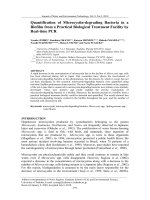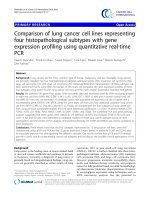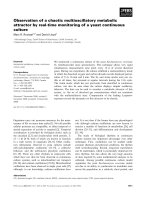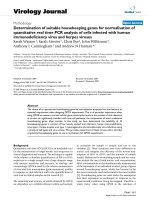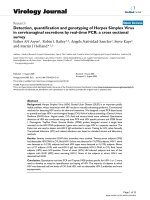Generation of mouse graves ophthalmopathy model with full length TSH receptor plasmid and cytokine evaluation by real time PCR
Bạn đang xem bản rút gọn của tài liệu. Xem và tải ngay bản đầy đủ của tài liệu tại đây (3.63 MB, 98 trang )
GENERATION OF MOUSE GRAVES’ OPHTHALMOPATHY
MODEL WITH FULL LENGTH TSH RECEPTOR PLASMID AND
CYTOKINE EVALUATION BY REAL-TIME PCR
GOH SUI SIN
(B.App.Sc., Queensland University of Technology, Australia)
A THESIS SUBMITTED
FOR THE DEGREE OF MASTER OF SCIENCE
DEPARTMENT OF OPHTHALMOLOGY
NATIONAL UNIVERSITY OF SINGAPORE
2005
Acknowledgements
Firstly, I would like to thank Prof. Donald Tan for supporting and allowing
me to pursue a Master’s degree and Dr. Daphne Khoo for those enjoyable years of
working under her supervision and for inspiring and supporting my pursue of a higher
degree.
I wish to express my utmost gratitude to Dr. Ho Su Chin for her diligence
and patience throughout the course of this project. Her immeasurable contributions
made this thesis a reality. I would like to thank her also for the close supervision,
clear guidance and great friendship she offered. Thank you for taking me under your
wings.
I would like to thank Assoc. Prof. Pierce Chow, Director of Experimental
Surgery for approving the running of experiments at the animal holding unit. To Ms.
Irene Kee who has so graciously offered her time and expertise in animal handling;
for the long hours of collecting blood with us, for extracting those tiny tissue samples
and for teaching me new skills, a big thank you.
I would like also to thank Dr. Zhao Yi, Dr. Michelle Tan and Ms. Lai Oi
Fah for imparting invaluable knowledge on Real-Time PCR technique and for giving
me advice on how to prepare my samples and write my thesis. Thanks to Dr.
Michelle Tan and Dr. Susan Lee for reading the thesis, making sure it’s
comprehensible.
i
To Mr. Edmund Chan and Ms. Jane Ng who had to put up with my messy
workbench and cluttered writing table, thank you. You guys are very nice people. It
has been great fun working with you and I am really glad we share the same lab.
I would like to thank Ms. Kala R., Ms. Nur Ezan Mohamed, Ms. Lai Oi
Fah, Ms. Lim Gek Keow and Ms. Puong Kim Yoong for inviting me to your meals.
Mr. Mat Rizan Mat Ari for sharing his food with me all the time. You guys have
been wonderful company, providing cheers, and comfort and listening ears.
I
sincerely thank you all.
To my dearest aunt, Ms. Goh Siew Teng for ‘nagging’ at me all the time to
finish my Master’s, for taking care of my ‘kids’ (Milo and Junior), and making sure
things run smoothly at home. Thank you from the bottom of my heart.
To my loving husband Mr. Ong Choon Yam, whose constant support and
encouragement never cease. Thank you for standing by me, have late dinners with
me and trying to stay up with me during those late nights. I love you for the person
you are.
Lastly, but most important of all, I thank GOD Almighty for watching over
me and for sending HIS blessings through the people around me.
ii
Contents
Acknowledgements
i
Table of Contents
iii
List of Abbreviations
vi
List of Figures
ix
List of Tables
xi
Summary
xiii
I. INTRODUCTION
1
1. Graves’ Disease (GD)
2
1.1. Diagnosis of Graves disease
3
1.2. The Antigen of Graves’ Disease: Thyrotropin Receptor (TSHR)
3
1.3. TSHR Autoantibodies in Graves’ Disease
7
1.4. Detection of TRAB
8
1.4.1. Indirect Competitive Assay (TBII Assay)
8
1.4.2. TSAB and TSBAB Assays
9
1.4.3. Detection of TRAB by Flow Cytometry
9
2. Graves’ Ophthalmopathy (GO)
2.1. T Lymphocytes (T cells) Development
11
12
2.1.1. Helper T Cells
13
2.1.2. Cytokines
15
2.2. Helper T Cell Involved in Graves’ Ophthalmopathy
17
iii
2.3. Animal Model of Graves’ Ophthalmopathy
18
2.3.1. Balb/c inbred versus Swiss Outbred mice
21
2.3.2. Genetic Immunization
22
2.3.3. Timing of blood and tissue sampling
23
2.4. Cytokine Profile Study using Real-Time PCR, TaqMan® Technology 23
II. AIMS OF STUDY
27
III. MATERIALS AND METHODS
29
1. Animal Experimentation
29
2. Sera Characterization
30
2.1. Flow Cytometry
31
2.2. TBII
31
2.3. TSAB and TSBAB
32
3. Cytokine Profile
32
3.1. RNA Extraction
33
3.2. Reverse Transcription
35
3.3. Real-Time Polymerase Chain Reaction (PCR)
36
4. Statistical Analyses
37
IV. RESULTS
38
1. RNA Extraction
38
2. Immunization of Balb/c and Swiss Outbred Mice
43
2.1. Weight
43
2.2. Total T4
46
2.3. FACS for TRAB Detection
47
2.4. TBII Assay
48
2.5. TSAB and TSBAB Bioassay
49
iv
3. T Cell Cytokine Profile using Real-Time PCR
3.1. Correlation of Cytokines with TRAB Measurements in Balb/c
53
55
3.2. Correlation of Cytokines with TRAB Measurements in Swiss Outbred 57
4. Summary of Findings
62
4.1. Changes after Genetic Immunization
62
4.2. Th1 and Th2 Cytokine Expression
62
V. DISCUSSION
66
1. Technical Difficulties
66
2. Discussion of Results
68
2.1. Genetic Immunization in Balb/c versus Swiss Outbred mice
68
2.1.1. Genetic Immunization findings in Balb/c mice
69
2.1.2. Genetic Immunization findings in Swiss Outbred mice
71
2.2. Significance of findings in Balb/c and Swiss outbred mice
74
2.3. Mouse GO versus Human GO
74
2.4. Clinical relevance of differences in cytokine profile in Mouse model 75
2.5. Limitation of current study
75
2.6. Possible Future Work / Experiments
76
VI. CONCLUSION
77
VII. REFERENCES
78
v
List of Abbreviations
γIFN
Gamma interferon
APC
Antigen presenting cell
BSA
Bovine serum albumin
cAMP
Cyclic adenosine 3’, 5’-cyclic monophosphate
cDNA
complementary deoxyribonucleic acid
CHO
Chinese hamster ovary
Ct
Cycle threshold
DNA
Deoxyribonucleic acid
EDTA
Ethylenediaminetetraacetic acid
EGTA
Ethylene glycol bis(2-aminoethyl ether)-N,N,N'N'-tetraacetic acid
FACS
Fluorescence-activated cell sorter
FRET
Fluorescence resonance energy transfer
GADPH
Glyceraldehyde-3-phosphate dehydrogenase
GAG
Glycosaminoglycans
GD
Graves’ disease
GM-CSF
Granulocyte-macrophage colony-stimulating factor
GO
Graves’ ophthalmopathy
GPCR
G protein-coupled receptor
HLA
Human leukocyte antigen
IgG
Immunoglobulin G
IL2
Interleukin 2
IL3
Interleukin 3
IL4
Interleukin 4
vi
IL5
Interleukin 5
IL10
Interleukin 10
KRH
Krebs-Ringer HEPES
MHC
Major histocompatibility complex
NK
Natural killer
PBS
Phosphate buffered saline
PCR
Polymerase chain reaction
Q
Quencher
R
Reporter
Rn
Reaction
RNA
Ribonucleic acid
RT-PCR
Reverse transcription Polymerase chain reaction
SD
Standard deviation
T4
Thyroxine
T3
Triiodothyronine
TBII
Thyrotropin binding inhibitor immunoglobulin
Tc
Cytotoxic T
TcR
T cell receptor
Tg
Thyroglobulin
TGF β
Transforming growth factor beta
Th
Helper T
TNF α
Tumour necrosis factor alpha
TNF β
Tumour necrosis factor beta
TPO
Thyroid peroxidase
TRAB
Anti-Thyrotropin receptor autoantibodies
vii
TRH
Thyrotropin releasing hormone
TSAB
Thyroid stimulating antibodies
TSBAB
Thyroid-stimulation blocking antibodies
TSH
Thyrotropin
TSHR
Thyrotropin receptor
viii
List of Figures
Figure 1
An illustration of the physiologic control of thyroid function
1
Figure 2
Activation of adenylyl cyclase following binding of TSH to TSHR 4
Figure 3
The Thyrotropin Receptor with known mutations marked
5
Figure 4
Schematic representation of different forms of the TSHR
6
Figure 5
A schematic representation of the relationship between quantities of
heterogeneous TRAB in Graves’ disease
7
Figure 6
FACS, Fluorescence Activated Cell Sorter
10
Figure 7
Histogram for TRAB bound and unbound population
10
Figure 8
Three classes of effector T cell specialized to deal with three
classes of pathogens.
13
Figure 9
Activation of helper T cell and differentiation into Th 1 cells
14
Figure 10
Suppression of Th cell by another Th cell which has been activated 15
Figure 11
Activities of an activated Th1 cell
16
Figure 12
Th2 cells acting on naive B cells
16
Figure 13
Semi-thin section of the thyroid
19
Figure 14
Semi-thin sections of extraocular muscles from immunized
hyperthyroid NMRI mice
19
Figure 15
Balb/c ocular muscle
20
Figure 16
Plasmid DNA immunization
22
Figure 17
Amplification curve
24
Figure 18
TaqMan® probe
24
Figure 19
Principles of TaqMan®
25
Figure 20
Schedule for genetic immunization and blood/tissue collection
29
ix
Figure 21
The eye of a rat in situ viewed from the top
33
Figure 22
RNA on 1% native agarose gel
42
Figure 23
Weight of mice at the start and the end of protocol
44
Figure 24
Total T4 measurement in Balb/c and Swiss outbred
46
Figure 25
TRAB level detection using FACS
47
Figure 26
TBII activity in BALB/c and Swiss Outbred
48
Figure 27
TSAB activity in Balb/c and Swiss Outbred
49
Figure 28
TSBAB activity in Balb/c and Swiss Outbred
50
Figure 29
Correlation between γ IFN and TSBAB in spleen of Balb/c
55
Figure 30
Correlation between IL2 and TBII in spleen of Balb/c
55
Figure 31
Correlation between IL2 and TSBAB in eye of Balb/c
56
Figure 32
Correlation between γ IFN and TSBAB in eye of Balb/c
56
Figure 33
Correlation between γ IFN and TBII in eye of Swiss outbred
57
Figure 34
Correlation between IL2 and TBII in thyroid of Swiss mice
58
Figure 35
Correlation between IL5 and FACS in spleen of Swiss outbred
59
Figure 36
Correlation between IL5 and FACS in spleen of Swiss outbred
60
Figure 37
Correlation between IL5 and TSBAB in spleen of Swiss mice
60
x
List of Tables
Table 1
TSH Binding Inhibitory Immunoglobulin (TBII) Assay
8
Table 2
Conversion of RNA to cDNA
35
Table 3
Real-Time PCR Reaction Mix and Cycling condition
36
Table 4
Absorbance readings for spleen RNA in Balb/c mice.
38
Table 5
Absorbance readings for thyroid RNA in Balb/c mice.
39
Table 6
Absorbance readings for orbit RNA in Balb/c mice.
40
Table 7
Absorbance readings for spleen RNA in Swiss Outbred mice.
41
Table 8
Absorbance readings for thyroid RNA in Swiss Outbred mice.
41
Table 9
Absorbance readings for orbit RNA in Swiss Outbred mice
42
Table 10
Weight changes in Mice between control and treated group at
beginning and end of experiment
45
Table 11
Total T4 median for control and treated mice
46
Table 12
FACS for control and treated mice
47
Table 13
TBII Levels in control and treated mice
48
Table 14
TSAB activity in sera of BALB/c and Swiss Outbred
49
Table 15
TSBAB activity in sera of Balb/c and Swiss Outbred
50
Table 16
Cut off values for the parameter to be considered positive
51
xi
Table 17
Cross tabulation of FACS status in the 2 strains of mice immunized
with TSHR
Table 18
Cross tabulation of TBII status in the 2 strains of mice immunized
with TSHR
Table 19
54
Relative fold change of Th2 cytokines to Th1 cytokines in mice
injected with TSHR plasmids
Table 23
52
Relative fold change of cytokine in Balb/c and Swiss outbred
mice injected with TSHR compared to controls
Table 22
52
Cross tabulation of TSBAB status in the 2 strains of mice immunized
with TSHR
Table 21
52
Cross tabulation of TSAB status in the 2 strains of mice immunized
with TSHR
Table 20
51
61
Summary of cytokine profile and immunological markers in
control and treated groups of Balb/c and Swiss outbred mice
65
xii
Summary
Graves’ ophthalmopathy is a potentially disfiguring, sight-threatening and
frequent complication of Graves’ disease. There is currently no option of preventive
treatment and management consists mainly of amelioration of inflammatory
processes which are usually well underway once clinical presentations become overt.
Lymphocytic infiltration of muscular and connective tissues of the retroorbital space
is a histological hallmark of Graves’ ophthalmopathy. The pathogenesis of Graves’
ophthalmopathy and whether it is the result of a Th1 or Th2 regulation remains
controversial. Study of inflammatory processes and cytokine profiling in human
tissue samples were limited by sample, genetic and technique heterogeneity.
Therefore, it is the aim of this study, to investigate the spectrum of T-lymphocyte
cytokines expressed in tissues (spleen, thyroid & orbit) of genetically immunized
inbred Balb/c and outbred Swiss mice by means of Real-Time PCR. These 2 mouse
strains were injected with plasmid encoding the thyrotropin receptor gene. The
results showed genetic immunization worked better in Swiss outbred than Balb/c. It
produced significantly higher numbers of mice positive for thyrotropin receptor
autoantibody (TRAB) detection by Flow Cytometry (FACS) and Indirect competitive
(TBII) assays in Swiss outbred compared to Balb/c. The titers of these 2 assays were
also significantly higher in outbred than in inbred mice. γIFN was found to be more
abundant in the thyroids of thyrotropin receptor vaccinated Balb/c mice than those of
controls. There was a dominance of γIFN and IL2 to IL5 in the ratio calculation of
the thyroidal cytokines. Thyroid-stimulation blocking antibody (TSBAB) also had a
linear relationship with the expression of Th1 cytokines i.e. γIFN in the spleens and
xiii
orbits and IL2 in the orbits of Balb/c mice. Expression of Th2 cytokine IL5 was
higher in Swiss outbred mice injected with thyrotropin receptor compared to controls
in the splenic and thyroidal tissues. There was also a drop in expression of IL2 (Th1)
cytokine in the vaccinated thyroid relative to control, which differ significantly from
that in Balb/c mice. There was also a large dominance of IL5 to IL2 or γIFN
expression in the ratio calculation and this contrast sharply with the findings in Balb/c
mice. The cytokine profile evaluation in the orbital tissues showed down regulation
of IL5 in Balb/c and γIFN, IL4 and IL5 in Swiss outbred mice. This would imply a
relatively quiescent immunological environment in this tissue compartment and thus
dominance of either Th1 or Th2 response cannot be determined with confidence. In
this study, genetic immunization of Balb/c tended towards a Th1 bias while Swiss
outbred mice tended towards a Th2 bias upon genetic immunization with the human
TSHR.
The 2 mouse strains were identical in the treatment, housing and
maintenance. The only variance is the genetic makeup of outbred and inbred mice.
Given the stronger antibody response in the Swiss outbred mice, it is possible that the
genetic diversity in outbred mice contribute to a more plausible model for human
Graves’ disease.
xiv
I. INTRODUCTION
The thyroid gland is a butterfly shaped organ located immediately below the
larynx anterior to the trachea. It secretes two important hormones, thyroxine (T4) and
triiodothyronine (T3). These hormones cause an increase in nuclear transcription of
large numbers of genes in virtually all cells of the body with resultant effect of large
increases in protein enzymes, structural proteins, transport proteins, and other
substances. The outcome of all these changes is a generalized increased in functional
activity throughout the body and a rise in the metabolic rate.
Under normal
physiological condition, production of these two hormones from the thyroid gland is
tightly regulated by thyrotropin (TSH) from the pituitary gland via a negative
feedback loop by the secreted thyroid hormone.
The hypothalamus also exerts
influence on the pituitary gland via the secretion of thyrotropin releasing hormone
(TRH) (Figure 1).
Figure 1. An illustration of the
physiologic control of thyroid
function.
↑ Iodide
↑ cAMP
In response to thyrotropin-releasing
hormone (TRH), the pituitary gland
secretes thyrotropin (TSH) which
stimulates iodine trapping and
increasing cAMP, thus thyroid
hormone synthesis, and release of
T3 and T4 by the thyroid gland.
TSH is regulated by feedback from
circulating
unbound
thyroid
hormones.
1
1. Graves’ Disease (GD)
Thyrotoxicosis is a clinical syndrome resulting from high levels of circulating
thyroid hormones which increases the body’s basal metabolic rate 60 - 100 per cent
above the normal.
This is often due to excessive thyroid secretion.
Common
manifestations include palpitation – sinus tachycardia or atrial fibrillation, agitation
and tremor, generalized muscle weakness, proximal myopathy, angina and heart
failure, fatigue, hyperkinesias, diarrhea, excessive sweating, intolerance to heat,
oligomenorrhea and subfertility. There is often weight loss despite normal appetite.
By far, Graves’ disease (GD) is the most common form of thyrotoxicosis and
may occur at any age, with a peak incidence in the 20- to 40-year age group with a
predisposition toward the female sex.
Graves’ disease is characterized by a
generalized increase in thyroid gland volume, termed goiter. In most patients, the
entire thyroid gland can be increased up to 2 - 3 times above normal. Other hallmark
features of the disease include thyroid eye disease termed Graves’ ophthalmopathy
(GO), and thyroid dermopathy termed pretibial myxedema. GO is the more common
extra-thyroidal manifestation of GD and is clinically evident in 25 - 50 percent of the
patients. The onset of GO may precede, coincide with, or follow the thyrotoxicosis.
It is characterized by proptosis, periorbital and conjunctival edema, extraocular
muscle dysfunction, and rarely, corneal ulceration or optic neuropathy. It can be a
disfiguring and potentially sight-threatening autoimmune disorder.
Thyroid
dermopathy, as seen in pretibial myxedema, is a painless thickening of the skin,
particularly over the lower tibia. It is due to the accumulation of glycosaminoglycans
(GAG) and is a relatively rare occurrence in GD (2 - 3%).
2
GD is an autoimmune disease characterized by the presence of autoantibodies
directed against the thyrotropin receptor (TSHR). These anti-TSHR autoantibodies
(TRAB) mimic the action of TSH and activate the TSHR independent of its natural
ligand. Receptor activation increases the downstream signal transduction with an
increase in cyclic AMP (cAMP) production. There is growth and proliferation of
thyrocytes and thyroid hormone T3 and T4 overproduction, leading to diffuse goiter
and thyrotoxicosis. These TRAB with stimulatory activity are known as thyroid
stimulating antibodies (TSAB) and is of IgG subtype.
1.1. Diagnosis of Graves’ Disease
Clinical diagnosis is made based on the triad of goiter, GO and pretibial
myxedema if present and confirmed through biochemistry by a combination of
suppressed TSH and elevated free T4. In early and recurrent Graves’ disease, T3 may
be secreted in excess before T4 is elevated. Therefore, if TSH is suppressed and free
T4 is not raised, serum T3 should be measured. GD patients have autoantibodies
against several thyroid antigens including thyroglobulin (Tg), thyroid peroxidase
(TPO) and TSHR [8, 9]. Among these, TRAB is the pathogenic autoantibody and
most critical in disease development. Testing of this autoantibody is useful in the
diagnoses of ‘apathetic’ hyperthyroid patient or patient who presents with unilateral
exophthalmos without obvious clinical features or laboratory manifestations of GD.
1.2. The Antigen in Graves’ Disease: Thyrotropin Receptor (TSHR)
The TSHR is the primary antigen in GD. It is the target of both antigenspecific T cells and B-cell derived antibodies. The binding of its cognate ligand TSH
or/and pathogenic TRAB changes the receptor and brings about the signal
3
transduction across the thyroid cell membrane. The TSHR has long been known to
signal via cAMP signal transduction pathway.
The receptor’s cAMP signal
transduction is regulated by TSH in a normal person. Growth and function of the
thyroid are stimulated by cAMP which indirectly regulates the expression of the Tg
and TPO genes. In Graves’ disease, TSAB mimicking the action of TSH presents a
continued stimulation of the cAMP pathway, thus causing hyperthyroidism (Figure
2).
Conversely, inhibition of this cascade by autoantibodies such as thyroid-
stimulation blocking antibodies (TSBAB) and thyrotropin binding inhibitor
immunoglobulin (TBII) that block the TSHR would result in hypothyroidism.
(i)
TSH / TRAB
(iii)
TSH
(ii)
(iv)
Figure 2. Activation of adenylyl cyclase following binding of TSH to TSHR.
(i)
(ii)
(iii)
(iv)
Following ligand binding to the receptor, a conformational change is induced
in the receptor to catalyze a replacement of GDP by GTP on Gα.
The Gα-GTP complex dissociates from Gγβ and binds to adenylyl cyclase,
stimulating cAMP synthesis.
Bound GTP is slowly hydrolyzed to GDP by GTPase activity of Gα.
Gα-GDP dissociates from adenylyl cyclase and reassociates with Gγβ. Gα and
Gγ are subunits linked to the membrane by covalent attachment to lipids [4].
4
The TSHR is the largest of all G protein-coupled receptors (GPCR) which
consists of a large extracellular ligand binding domain linked to seven transmembrane
segments, and an intracellular tail. It is found to be much more susceptible to
constitutive activation by mutations, deletions, or even mild trypsin digestion than
other GPCRs (Figure 3) [7].
Figure 3. The Thyrotropin Receptor with known mutations marked.
Gain-of-function mutations are denoted by circles ( ) in the case of hyperfunctioning
thyroid adenomas, squares ( ) in the case of familial autosomal dominant hyperthyroidism,
diamonds ( ) in the case of sporadic congenital hyperthyroidism, and octagons ( ) in the
case of thyroid carcinomas. Loss-of-function mutations are denoted by triangles ( ).
Letters indicate the amino acid in the wild-type receptor. The asterisk (*) and double
asterisk (**) indicate deletions resulting in a gain of function in hyperfunctioning thyroid
adenomas [7].
5
The TSHR is unusual among the GPCRs in that the single-chain TSHR
undergoes intramolecular cleavage to form ligand-binding, disulfide-linked subunits
A (α, N-terminal extracellular portion) and B (β, membrane bound). A segment of
~50 residues (C-peptide region) is removed from the N-terminal end of the B subunit
(Figure 4(i)).
This process also leads to the shedding of heavily glycosylated
autoantibody-binding A-subunits from the cell surface which is preferentially
recognized by TSAB (Figure 4(ii)). The shed A-subunits have been shown to bind
TSH even without the B-subunit. These post-translational processes (cleavage and Asubunit shedding) are regulated by TSH [6]. Majority of the epitopes for TSAB are
present on the N-terminal region between amino acid residues 25 and 165 of the
extracellular domain while those for TSBAB and TBII are on the C-terminal region
(between amino acid residues 261 and 370) [10]. However, recent studies using
monoclonal antibodies on TSHR epitopes indicate a much closer overlap of TSAB
and TSBAB binding sites [11].
(i)
(ii)
Major portion
of TSAB
epitope(s)
TSH holoreceptor
Figure 4. Schematic representation of different forms of the TSHR.
(i)
(ii)
Intramolecular cleavage of the single polypeptide chain is followed by
removal of the C peptide region, with the A subunit remaining tethered to the
membrane-spanning B-subunit by disulfide bonds.
The autoantibody-binding A-subunit [6].
6
1.3. TSHR Autoantibodies in Graves’ Disease
TSHR autoantibodies (TRAB) show functional heterogeneity. Autoantibodies
which mimic TSH action to stimulate thyroid hormone production are called thyroidstimulating antibodies (TSAB), while those which block TSH actions are called
thyroid-stimulation blocking antibodies (TSBAB).
Antibodies that inhibit TSH
binding to the receptor are called TSH-binding inhibitor immunoglobulin (TBII) [12].
GD patients have all three antibodies frequently coexisting in their blood (Figure 5).
In general, TSAB should dominate over other TRAB during hyperthyroid phase of
GD.
They can also cause transient neonatal hyperthyroidism by transplacental
crossing of IgG from mother to fetus. TSAB are restricted to the IgG subclass, while
TSBAB are not restricted to a given subclass of immunoglobulin [13].
TBII
TSAB
TSBAB
Figure 5. A schematic representation of the relationship between
quantities of heterogeneous TRAB in Graves’ disease [5].
7
1.4. Detection of TRAB
TRAB is useful for differential diagnosis of GD from other causes of
hyperthyroidism, for follow up of patients with GD under treatment with antithyroid
drugs, for the diagnosis of GO and for monitoring GD in pregnancy or after delivery.
It can be detected and measured by 3 methods:
1.
Indirect competitive assay (TBII assay),
2.
Measurement of cAMP levels stimulation in the case of TSAB, or
measurement of suppression of TSH-mediated cAMP production in the case
of TSBAB,
3.
Flow cytometry.
1.4.1. Indirect Competitive Assay (TBII Assay)
This is a competitive assay where TRAB and I125 labeled bovine TSH
compete for the binding sites on the TSHR (Table 1). TRAB inhibit labeled TSH
binding to the TSHRs in a dose- and time-dependent manner. This assay does not
distinguish between stimulating and blocking TRAB.
Table 1. TSH Binding Inhibitory Immunoglobulin (TBII) Assay
TSHr on JP26 cells
TRAB
TRAB
TRAB in mouse serum
Bovine TSH
8
1.4.2. TSAB and TSBAB Assays
Interaction of stimulating TRAB at the TSHR results in cAMP production as
shown in Figure 2. TSAB assay is carried out by measuring the amount of cAMP
generated from incubation of stimulating TRAB with cells expressing TSHRs over a
measured period of time. TSBAB is similarly performed except that in this case,
incubation of blocking TRAB is done in the presence of TSH and cells expressing
TSHRs. Since blocking TRAB inhibits TSH, a reduction of TSH-mediated cAMP
generation is detected. Cyclic AMP can be measured in the intra- or extra-cellular
compartment and is usually done with a radioimmunoassay kit.
1.4.3. Detection of TRAB by Flow Cytometry
In this method, cells expressing TSHRs are incubated in the presence of
TRAB-positive sera and detection is done by a secondary antibody conjugated with a
fluorescein dye. Cells prepared in this manner are then put through a fluorescenceactivated cell sorter (FACS) (Figure 6). The cell stream that is passing out of the
chamber is encased in a sheath of buffer fluid and illuminated by a laser. Each cell is
measured for size (forward light scatter) and granularity (90o light scatter), as well as
for presence of colored fluorescence. Thus by measuring the fluorescence intensity
of each cell after interrogation by a laser beam, the machine is able to distinguish
TRAB bound and non-TRAB bound cells (Figure 7).
9
Figure 6. FACS, Fluorescence Activated Cell Sorter
TRAB positive and TRAB negative sera can be identified based on their
fluorescent brightness [2].
TRAB negative
TRAB positive
Figure 7.
Histogram for
TRAB bound and unbound
population
Y-axis denotes number of cells
while
X-axis
showed
fluorescence
for
two
populations.
10
